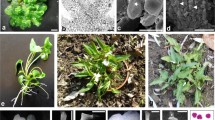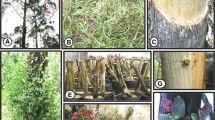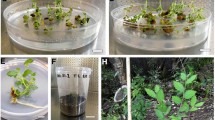Abstract
Efficient vegetative cloning in vitro requires definition of plant growth regulator regimes for each genotype, and therefore formulation of a uniform culture protocol for a genetically heterogeneous wild or uncultivated plant population is often impossible. The likelihood of cloning a wide array of plant genotypes by avoiding the use of plant growth regulator(s) was explored with Moringa oleifera Lamk., Moringa stenopetala (Baker f.) Cufod, and Moringa peregrina Forssk. ex Fiori tree seedlings. Propagation was achieved by multiple shoot regeneration from the cotyledonary node of decapitated seedlings, followed by axillary shoot growth from single node shoot segments and rooting of excised shoots. All steps were accomplished on basal Murashige and Skoog medium without plant growth regulator supplements. The results revealed competence for generation of multiple shoots from cotyledonary node tissue, stimulated by repeated shoot harvest, in seedlings of all three tree species. Tens of plants per seedling were regenerated in about 4 mo from culture initiation. In a given species clone size was seedling-dependent, which presumably stems from genotypic variability among seedlings in regeneration ability in vitro. By this means the laborious search for a plant growth regulator regime suitable for organogenesis induction and adapted per genotype became redundant, and biodiversity of the seed germplasm could be maintained. The approach ideally suits establishment of clones of wild plants of endangered species, like those of the Moringaceae, species with high ability for producing supplementary shoots, and without the need to add plant growth regulators, including the rooting stage.




Similar content being viewed by others
References
Anwar F.; Latif S.; Ashraf M.; Gilani A. H. Moringa oleifera: a food plant with multiple medicinal uses. Phytother. Res. 21: 17–25; 2006. doi:10.1002/ptr.2023.
Alvarez N. D. G.; Meeking R. J.; White D. W. R. The origin, initiation and development of axillary shoot meristems in Lotus japonicus. Ann. Bot. 98: 953–963; 2006. doi:10.1093/aob/mcl187.
Bennett R. N.; Mellon F. A.; Foidl N.; Pratt J. H.; Dupont M. S.; Perkins L.; Kroon P. A. Profiling glucosinolates and phenolics in vegetative and reproductive tissues of the multi-purpose trees Moringa oleifera L; (horseradish tree) and Moringa stenopetala L. J. Agric. Food Chem. 51: 3546–3553; 2003. doi:10.1021/jf0211480.
Duke J. A. Moringa oleifera Lam. (Moringaceae). In: Duke J. A. (ed) Handbook of nuts. CRC Press, Boca Raton, pp 214–217; 2001.
Fay F. M. In what situations is in vitro culture appropriate to plant conservation? Biodivers. Conserv. 3: 176–183; 1994. doi:10.1007/BF02291887.
Gamborg O. L.; Miller R. A.; Ojima K. Nutrient requirement of suspension cultures of soybean root cells. Exp. Cell Res. 50: 151–158; 1968. doi:10.1016/0014-4827(68)90403-5.
Gidamis A. B.; Panga J. T.; Sarwatt S. V.; Chove B. E.; Shayo A. B. Nutrient and antinutrient contents in raw and cooked young leaves and immature pods of Moringa oleifera Lam. Ecol Food Nutr 43: 399–411; 2003. doi:10.1080/03670240390268857.
Graham A. W.; Wallwork M. A.; Sedgley M. Lignotuber bud development in Eucalyptus cinerea (F. Muell. ex benth). Int. J. Plant Sci. 159: 979–988; 1998.
Grbić V.; Bleecker A. B. Axillary meristem development in Arabidopsis thaliana. Plant J. 21: 215–223; 2000. doi:10.1046/j.1365-313x.2000.00670.x.
Hakham E.; Ritte U. Forage pressure of the Nubian ibex Capra ibex-nubiana and its effect on the indigenous vegetation of the En Gedi nature-reserve, Israel. Biol. Conserv. 63: 9–21; 1993. doi:10.1016/0006-3207(93)90068-C.
Hammer K.; Khoshbakht K. Towards a ‘red list’ for crop plant species. Genet. Resour. Crop Evol. 52: 249–265; 2005. doi:10.1007/s10722-004-7550-6.
Islam S.; Jahan M. A. A.; Khatum R. In vitro multiplication of year-round fruit bearing Moringa oleifera L. J. Biol. Sci. 5: 145–148; 2005.
Lalas S.; Tsaknis J.; Sflomos K. Characterisation of Moringa stenopetala seed oil variety “Marigat” from island Kokwa. Euro. J. Lipid Sci. Technol. 105: 123–31; 2003. doi:10.1002/ejlt.200390002.
Mibus R.; Sedgley M. Early lignotuber formation in Banksia—Investigations into the anatomy of the cotyledonary node of two Banksia (Proteaceae) species. Ann. Bot. 86: 575–587; 2000. doi:10.1006/anbo.2000.1219.
Mohan V.; Purohit M.; Srivastava P. S. In vitro micropropagation of Moringa pterygosperma. Phytomorphology 45: 253–261; 1995.
Morton J. F. The horseradish tree, Moringa pterygosperma (Moringaceae)—a boon to arid lands? Econ. Bot. 45: 318–333; 1991.
Murashige T.; Skoog F. A revised medium for rapid growth and bioassays with tobacco tissue cultures. Physiol. Plant 15: 473–497; 1962. doi:10.1111/j.1399-3054.1962.tb08052.x.
Odee D. W.; Muluvi G. M.; Machua J.; Olson M. E.; Changwony M. Domestication of Moringa species in Kenya; 2001. http://www.moringanews.org/actes/odee_en.doc. Cited 23 April 2008.
Olson M. E. Combining data from DNA sequences and morphology for a phylogeny of Moringaceae (Brassicales). Systematic Bot. 27: 55–73; 2002.
Olson M. E.; Razafimandimbison S. G. Moringa hildebrandtii (Morongaceae): a tree extinct in the wild but preserved by indigenous horticultural practices in Madagascar. Adansonia 22: 217–221; 2000.
Pascual G.; Molinas M.; Verdaguer D. Comparative anatomical analysis of the cotyledonary region in three Mediterranean Basin Quercus (Fagaceae). Amer. J. Bot. 89: 383–392; 2002. doi:10.3732/ajb.89.3.383.
Sánchez N. R.; Ledin S.; Ledin I. Biomass production and chemical composition of Moringa oleifera under different management regimes in Nicaragua. Agrofor. Syst. 66: 231–242; 2006. doi:10.1007/s10457-005-8847-y.
Sarasan V.; Cripps R.; Ramsay M. M.; Atherton C.; McMichen M.; Prendergast G.; Rowntree J. K. Conservation in vitro of threatened plants—progress in the past decade. In Vitro Cell. Dev. Biol.-Plant 42: 206–214; 2006. doi:10.1079/IVP2006769.
Shibru, S. A wonderful but neglected tree species in Ethiopia—Shiferaw (cabbage tree); 2003. http://www.geocities.com/akababi/simon.htm. Cited 23 April 2008.
Steinitz B.; Amitay A.; Gaba V.; Tabib Y.; Keller M.; Levin I. A simple plant regeneration-ability assay in a range of Lycopersicon species. Plant Cell Tissue Organ Cult. 84: 269–278; 2006. doi:10.1007/s11240-005-9032-8.
Stephenson K. K.; Fahey J. W. Development of tissue culture methods for the rescue and propagation of endangered Moringa spp. germplasm. Econ. Bot. 58suppl: S116–S124; 2004. doi:10.1663/0013-0001(2004)58[S116:DOTCMF]2.0.CO;2.
Suarez M.; Entenza J. M.; Doerries C.; Meyer E.; Bourquin L.; Sutherland J.; Marison I.; Moreillon P.; Mermod N. Expression of a plant-derived peptide harboring water-cleaning and antimicrobial activities. Biotechnol. Bioeng. 81: 13–20; 2003. doi:10.1002/bit.10550.
Veeraragava Thatham D. Drumstick (Moringa oleifera Lam.). In: Veeraragava Thatham D.; Jawaharlal M.; Seemanthini R. (eds) A guide on vegetable culture. Suri Associates, Coimbatore, India, pp 139–143; 1998.
World Conservation Monitoring Centre. Moringa arborea. IUCN 2006. 2006 IUCN Red List of Threatened Species; 1998. http://www.iucnredlist.org/. Cited 23 April 2008.
Acknowledgements
Contribution from the Agricultural Research Organization, The Volcani Center, Bet Dagan, Israel, No. 110/07. We thank Michael Blecher, for providing Moringa peregrina seeds collected in Ein Gedi nature-reserve, Israel, and Drs. A. Zelcer and E. D. Ungar for helpful comments on the manuscript.
Author information
Authors and Affiliations
Corresponding author
Additional information
Editor: Gregory C. Phillips
Rights and permissions
About this article
Cite this article
Steinitz, B., Tabib, Y., Gaba, V. et al. Vegetative micro-cloning to sustain biodiversity of threatened Moringa species. In Vitro Cell.Dev.Biol.-Plant 45, 65–71 (2009). https://doi.org/10.1007/s11627-008-9162-x
Received:
Accepted:
Published:
Issue Date:
DOI: https://doi.org/10.1007/s11627-008-9162-x




